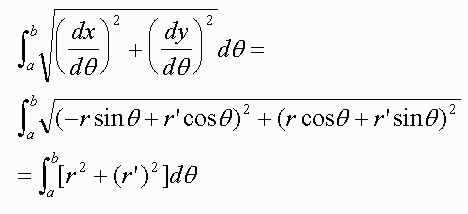Polar Area and Acrlength
I. Quiz
II. Homework
III. Area
If we have a region defined by r = r(theta), theta = a and theta = b, what is the area of the region?
If r is the arc of a circle then we want to find the area of the sector of the circle. If theta = b - a then the area = 1/2 theta r2
This is true since the area of the entire circle is pi r2. We can set up the relationship:
A/(pi r2) = theta/2pi so that A = (pi r2 theta)/2pi = 1/2 theta r2
Cutting the region into tiny d theta pieces, we have
dA = 1/2 r(theta)2 d theta
Adding up all the pieces, we arrive at

Exercise
Find the area enclosed by the curve r = 2cos theta
IV. Arclength
Since the arclength of a parameterized curve is given by
int sqrt[(dx/dtheta)2 + (dy/d theta)2 ]d theta,
we have
that for polar coordinates, letting x(theta) = r(theta)cos(theta) = rcos(theta)
and y(theta) = r(theta)sin(theta) = rsin(theta)
we have

We also have that the surface area of revolution is
2pi int rsin(theta sqrt[r2 + r'2]dtheta
Find the length of the 8 petalled flower r = cos(4 theta)
Solution:
We find the length of one of the petals and multiply by 8.
We see that the right petal goes through the origin at -pi/8 and next at pi/8.
Hence we integrate
int from -pi/8 to pi/8 sqrt(cos2(4 theta) + 18sin2 (4 theta) d theta.
This is best done with a calculator.
Exercise: Find the length of the curve r = 5(1 + cos(theta)) between 0 and 2pi.
V. Surface Area of Revolution
We have the following two formulas:
If r = r(theta) is revolved around the polar axis (x-axis) then the Surface area is

If it is revolved around the y-axis then the resulting surface area is

Exercise: Use your graphing calculator to find the area the results when r = 1 + cos(theta) is revolved around the y-axis.